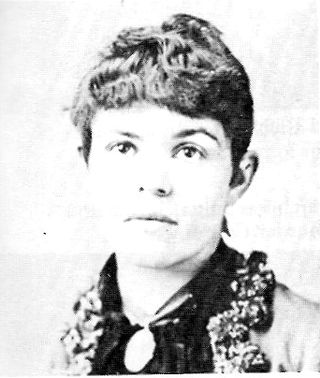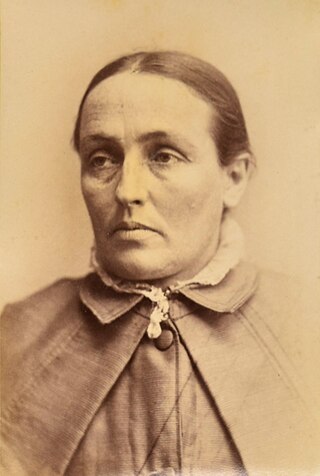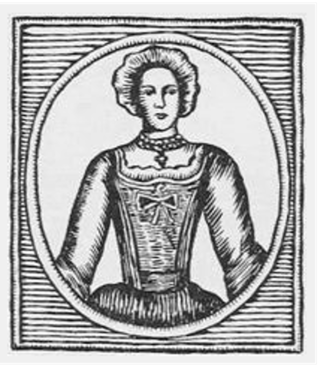Related Research Articles

Clavering is a village and also a parish in north-west Essex in England. It is about 20 miles (32 km) from Cambridge and 50 miles (80 km) from Southend-on-Sea. The name 'Clavering' means 'place where clover grows'.

William Palmer, also known as the Rugeley Poisoner or the Prince of Poisoners, was an English doctor found guilty of murder in one of the most notorious cases of the 19th century. Charles Dickens called Palmer "the greatest villain that ever stood in the Old Bailey".

The Pimlico Mystery or the Pimlico Poisoning Mystery is the name given to the circumstances surrounding the 1886 death of Thomas Edwin Bartlett, possibly at the hands of his wife, Adelaide Blanche Bartlett, in the Pimlico district of London. A fatal quantity of chloroform was found in Mr Bartlett's stomach, despite having not caused any damage to his throat or windpipe, and no evidence of how it got there. Adelaide Bartlett was tried for her husband's murder and was acquitted. By the jury's own statement in court Mrs Bartlett's acquittal was partly secured because the prosecution could not prove how Mrs Bartlett could have committed the crime.

Daisy Louisa C. de Melker, simply known as Daisy de Melker, was a South African nurse who was accused of poisoning two husbands with strychnine for their life insurance money; all she was found guilty of, however, was poisoning her only son with arsenic for reasons which are still unclear. De Melker is the second woman to have been hanged in South African criminal history.
Elizabeth Van Valkenburgh was an early American murderer who was hanged for poisoning her husband.
Mariticide literally means the killing of one's own husband. It can refer to the act itself or the person who carries it out. It can also be used in the context of the killing of one's own boyfriend. In current common law terminology, it is used as a gender-neutral term for killing one's own spouse or significant other of either sex. Conversely, the killing of a wife or girlfriend is called uxoricide.

Mary Ann Cotton was an English convicted murderer who was executed for poisoning her stepson. Despite her sole conviction for murder, she is believed to have been a serial killer who killed many others including 11 of her 13 children and three of her four husbands for their life insurance policies. Her preferred method of killing was poisoning with arsenic.

Wynne Edwin Baxter FRMS FGS was an English lawyer, translator, antiquarian and botanist, but is best known as the coroner who conducted the inquests on most of the victims of the Whitechapel Murders of 1888 to 1891 including three of the victims of Jack the Ripper in 1888, as well as on Joseph Merrick, the "Elephant Man".
Ann Bilansky was an American housewife convicted in 1859 of poisoning her husband with arsenic. She is the only woman in Minnesota to receive the death penalty and the first white person in the state to be executed by hanging.

His Majesty's Prison Lewes is a local category B prison located in Lewes in East Sussex, England. The term local means that the prison holds people on remand to the local courts, as well as sentenced prisoners. The prison is operated by His Majesty's Prison Service.
James Alexander Seton was the last British person to be killed in a duel on British soil.
Sarah Dazley, later known as The Potton Poisoner, was an English murderer convicted of the poisoning of her husband William Dazley. She was suspected of, but not tried for, the poisoning of her first husband Simeon Mead and their son Jonah Mead in 1840. The murder of William Dazley took place in Wrestlingworth, England.

Louisa Collins 11 August 1847 – 8 January 1889) was an Australian convicted murderer. She lived in the Sydney suburb of Botany and married twice, with both husbands dying of arsenic poisoning under suspicious circumstances. Collins was tried for murder on four separate occasions, with the first three juries failing to reach a verdict. At the fourth trial the jury delivered a guilty verdict for the murder of her second husband and she was sentenced to death. Louisa Collins was hanged at Darlinghurst Gaol on the morning of 8 January 1889. She was the first woman hanged in Sydney and the last woman to be executed in New South Wales.
Rebecca Smith was the last British woman to be executed for the infanticide of her own child. She was convicted of killing her infant son Richard, and was publicly hanged at Devizes, Wiltshire. After her trial she confessed to having poisoned seven of her other children.
The Richmond child murder was the case of Amy Gregory who was convicted in 1895 of strangling to death her daughter, Frances Maud Gregory, whose dead body was found on the ice in the Old Deer Park, Richmond, England. She was granted a reprieve from execution by the Home Secretary.
The trial of Kate Dover of February 1882, before Mr Justice Cave, was a major event at the criminal court in Leeds Town Hall, Leeds, West Yorkshire, England. It was attended by many people, and attracted much newspaper publicity. It followed the death of Kate Dover's 61-year-old employer and lover, Thomas Skinner from arsenic poisoning. Known as the Queen of Heeley for her fashionable taste in clothes, Dover was 27 years old at the time, and was Skinner's housekeeper. She was convicted of manslaughter, and sentenced to penal servitude for life, which she served at Woking Female Prison. By 1901, she was out of jail. She lived her remaining years with her sisters in Rotherham.

Catherine Foster (1829–1847) was an English woman who murdered her husband after three weeks of marriage. She was not yet 18 when hanged and was one of the youngest females ever hung in England.
Véronique Frantz was a French serial killer. While working as a maid, she poisoned her employers and a neighbor of theirs with arsenic from 1852 to 1854, in an attempt to marry her male employer. After his death, she was arrested, charged and convicted of the three murders, for which she was subsequently executed in 1854.
Annie Hearn was the assumed but known name of an arsenic poisoner in England in the 1920s/30s. Whilst Annie was found not guilty, all modern opinion concludes the weight of evidence would point to her having murdered at least three people.
Sarah Chesham was the last woman to be executed for attempted murder in the United Kingdom. She was accused of having poisoned her husband and several children over her lifetime, with locals giving her the nickname Sally Arsenic.
References
- 1 2 3 "Sarah Ann French". www.capitalpunishmentuk.org.
- ↑ "The female publicly hanged 1800 - 1868". www.capitalpunishmentuk.org.
- 1 2 "Chiddingly, East Sussex, OPC Page - Onion Pie Murder". www.sussex-opc.org.
- 1 2 "NOSTALGIA: Where many infamous criminals met their end". eastbourneherald.co.uk. 2 December 2016.
- 1 2 3 "Chiddingly, East Sussex, OPC Page - Onion Pie Murder". www.sussex-opc.org.